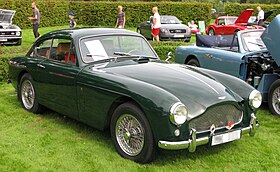Aston Martin DB Mark III
This article needs additional citations for verification. (April 2018) |
| Aston Martin DB Mark III | |
|---|---|
 1957 Aston Martin DB 2/4 Mark III | |
| Overview | |
| Manufacturer | Aston Martin |
| Production | 1957–1959 551 produced |
| Designer | John Turner |
| Body and chassis | |
| Class | Grand tourer |
| Body style | 2+2 hatchback 2-seat coupé 2-seat drophead |
| Layout | FR layout |
| Powertrain | |
| Engine | 2.9 L Lagonda I6 |
| Dimensions | |
| Wheelbase | 99 in (2,515 mm) |
| Length | 172 in (4,369 mm) |
| Width | 65 in (1,651 mm) |
| Height | 53.5 in (1,359 mm) |
| Kerb weight | 3,000 lb (1,361 kg) |
| Chronology | |
| Predecessor | Aston Martin DB2/4 Mk II |
| Successor | Aston Martin DB4 |
The DB 2/4 Mark III (normally simply called DB Mark III, even at the time of its introduction) is a grand tourer sold by Aston Martin from 1957 until 1959. It was an evolution of the DB2/4 Mark II model it replaced, using an evolution of that car's W.O. Bentley-designed 2.9 L (2922 cc/178 in³) Lagonda straight-6 engine, redesigned by Tadek Marek.
It was succeeded by the Aston Martin DB4 in 1958.
Overview
[edit]Changes included the front grille, that would become the shape of all future Aston Martin models (designed by Bert Thickpenny), a new instrument panel, and available Girling disc brakes. The hydraulically operated clutch was new as well, and an optional Laycock-de Normanville overdrive that was attached to the standard four-speed gearbox after the first 100 cars or even an automatic transmission were available. Worm-and-sector steering and a live axle rear end were carryovers. At the rear, the DB2/4 Mark II's tailfins (after the earliest few cars) were altered to use the rear lights from the Humber Hawk.
The standard DBA engine model with twin SU carburettors produced 162 hp (121 kW), though an optional dual-exhaust system raised this to a reputed 178 hp (133 kW). Thus equipped, the car could reach 60 mph (97 km/h) in 9.3 seconds and hit 120 mph (193 km/h).
A mid-level DBD option with triple SU 1.75" carbs and dual exhaust produced 180 hp (134 kW), and was fitted to 47 cars.
A high-output DBB engine with three twin-choke Weber 35 DCO 3 carburettors, special long duration camshafts, high compression 8.6:1 pistons and the dual-exhaust system was rated at 195 hp (145 kW) and ordered on just 10 cars.
One car was fitted with the special DBC competition engine with a reputed 214 b.h.p., this was fitted with racing camshafts, special connecting rods, very high compression pistons (possibly 9.5:1) & three twin-choke Weber 45 DCO 3 carburettors.
 |
 |
Girling disc brakes were fitted as standard to the front wheels of all Mark III Astons after the first 100 had been made. Many cars were upgraded later. Only five automatic cars were made from a total of 551.
A hatchback body style, complete with fold-down rear seats, was introduced in the 2/4 MkI in 1953.
A 1959 review by The US automobile magazineRoad & Track praised the car for everything but its $7,450 price. "A car for connoisseurs," they called it. "The Aston has many virtues and few faults." Among the faults was too-heavy steering effort, high door sills, and a stiff ride.
Coupé, convertible
[edit]
Along with the hatchback, two two-seater coupé variants of the Mark III were also produced. A "drophead coupé" convertible, while not common, still considerably outnumbers the "fixed head coupé" – 84 of the former were produced, while just five of the latter were built. All five Fixed Head Coupés were built close to the end of Mark III production and feature the mid-spec DBD engine.[1] Both of these body styles feature conventional hinged boot lids rather than the innovative hatchback.
James Bond
[edit]James Bond drives an Aston Martin DB Mark III in the novel version of Goldfinger, though it is referred to as a "DB III" in the book – the chapter in which he drives to his famous golf-course encounter with the villain is entitled 'Thoughts in a DB III'. It is the only Bond car in the Ian Fleming novels to have gadgets installed. For the film adaptation five years later, the car was updated to the Aston Martin DB5 model and the array of gadgetry was much expanded. That model was to become one of the most iconic of classic cars as a result.
Production
[edit]- DB Mark III: 551
- Hatchback: 462
- Drophead Coupé: 84
- DBA: 68
- DBB: 2
- DBD: 14
- Fixed Head Coupé: 5
LHD: 83
Die-cast models
[edit]The DB Mk III was included in the Spot-on range in the early 1960s.
Oxford Die-Cast have issued models of both the hatchback and the drophead.
Spark Models have issued 1/43 models of the drophead, labelled "DB2/4 Cabriolet 1959".
References
[edit]- ^ "DB 2/4 MkIII". Aston Service Dorset. Archived from the original on 13 August 2021. Retrieved 19 June 2013.
Further reading
[edit]- "Aston Martin DB Mark III". AstonMartins.com. Retrieved 23 June 2005.
- "Aston Martin Mark III". Road & Track (1959 Road Test Annual): 34–36.
